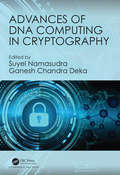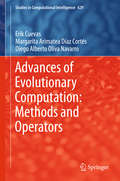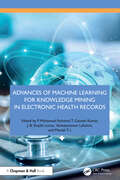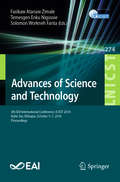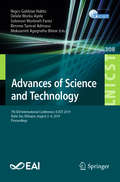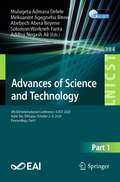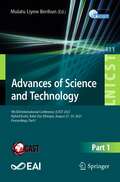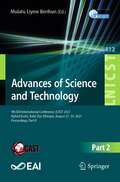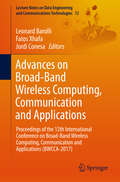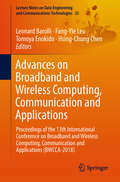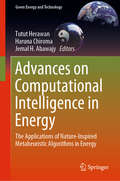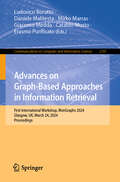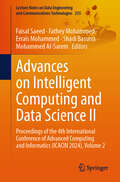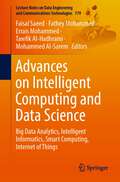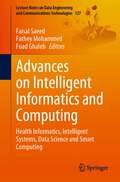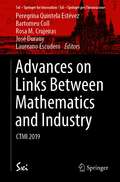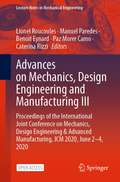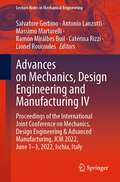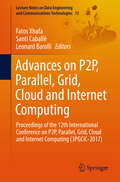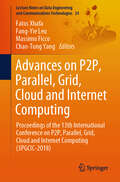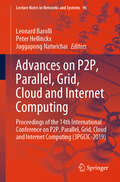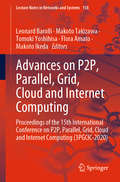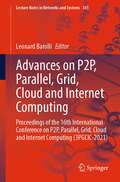- Table View
- List View
Advances of DNA Computing in Cryptography
by Ganesh Chandra Deka Suyel NamasudraThis book discusses the current technologies of cryptography using DNA computing. Various chapters of the book will discuss the basic concepts of cryptography, steganography, basic concepts of DNA and DNA computing, approaches of DNA computing in cryptography, security attacks, practical implementaion of DNA computing, applications of DNA computing in the cloud computing environment, applications of DNA computing for big data, etc. It provides a judicious mix of concepts, solved examples and real life case studies.
Advances of Evolutionary Computation: Methods and Operators (Studies in Computational Intelligence #629)
by Erik Cuevas Margarita Arimatea Díaz Cortés Diego Alberto Oliva NavarroThe goal of this book is topresent advances that discuss alternative Evolutionary Computation (EC) developmentsand non-conventional operators which have proved to be eective in the solutionof several complex problems. The book has been structured so that each chaptercan be read independently from the others. The book contains nine chapters withthe following themes: 1) Introduction, 2) the Social Spider Optimization (SSO),3) the States of Matter Search (SMS), 4) the collective animal behavior (CAB)algorithm, 5) the Allostatic Optimization (AO) method, 6) the Locust Search(LS) algorithm, 7) the Adaptive Population with Reduced Evaluations (APRE)method, 8) the multimodal CAB, 9) the constrained SSO method.
Advances of Machine Learning for Knowledge Mining in Electronic Health Records
by Venkataraman Lakshmi T. Ganesh Kumar P. Mohamed Fathimal Shajilin Loret, J. B. T. I. ManishThe book explores the application of cutting-edge machine learning and deep learning algorithms in mining Electronic Health Records (EHR). With the aim of improving patient health management, this book explains the structure of EHR consisting of demographics, medical history, and diagnosis, with a focus on the design and representation of structured, semi-structured, and unstructured data. Explains the design of organized, semi-structured, unstructured, and irregular time series data of electronic health records Covers information extraction, standards for meta-data, reuse of metadata for clinical research, and organized and unstructured data Discusses supervised and unsupervised learning in electronic health records Describes clustering and classification techniques for organized, semi- structured, and unstructured data from electronic health records This book is an essential resource for researchers and professionals in fields like computer science, biomedical engineering, and information technology, seeking to enhance healthcare efficiency, security, and privacy through advanced data analytics and machine learning.
Advances of Science and Technology: 6th EAI International Conference, ICAST 2018, Bahir Dar, Ethiopia, October 5-7, 2018, Proceedings (Lecture Notes of the Institute for Computer Sciences, Social Informatics and Telecommunications Engineering #274)
by Fasikaw Atanaw Zimale Temesgen Enku Nigussie Solomon Workneh FantaThis book constitutes the refereed post-conference proceedings of the 6th International Conference on Advancement of Science and Technology, ICAST 2018, which took place in Bahir Dar, Ethiopia, in October 2018. The 47 revised full papers were carefully reviewed and selected from 71 submissions. The papers present economic and technologic developments in modern societies in five tracks: agro-processing industries for sustainable development, water resources development for the shared vision in blue Nile basin, IT and computer technology innovation, recent advances in electrical and computer engineering, progresses in product design and system optimization.
Advances of Science and Technology: 7th EAI International Conference, ICAST 2019, Bahir Dar, Ethiopia, August 2–4, 2019, Proceedings (Lecture Notes of the Institute for Computer Sciences, Social Informatics and Telecommunications Engineering #308)
by Solomon Workneh Fanta Nigus Gabbiye Habtu Delele Worku Ayele Bimrew Tamrat Admasu Mekuanint Agegnehu BitewThis book constitutes the refereed post-conference proceedings of the 7th International Conference on Advancement of Science and Technology, ICAST 2019, which took place in Bahir Dar, Ethiopia, in August 2019. The 76 revised full papers were carefully reviewed and selected from more than 150 submissions. The papers present economic and technologic developments in modern societies in five tracks: agro-processing industries for sustainable development, water resources and environmental engineering, recent advances in electrical, electronics and computing technologies, product design, manufacturing and systems organization, and material science and engineering.
Advances of Science and Technology: 8th EAI International Conference, ICAST 2020, Bahir Dar, Ethiopia, October 2-4, 2020, Proceedings, Part I (Lecture Notes of the Institute for Computer Sciences, Social Informatics and Telecommunications Engineering #384)
by Solomon Workneh Fanta Mekuanint Agegnehu Bitew Mulugeta Admasu Delele Abebech Abera Beyene Addisu Negash AliThis two-volume set constitutes the refereed post-conference proceedings of the 8th International Conference on Advancement of Science and Technology, ICAST 2020, which took place in Bahir Dar, Ethiopia, in October 2020.The 74 revised full papers were carefully reviewed and selected from more than 200 submissions of which 157 were sent out for peer review. The papers present economic and technologic developments in modern societies in 6 tracks: Chemical, food and bio-process engineering; Electrical and computer engineering; IT, computer science and software engineering; Civil, water resources, and environmental engineering; Mechanical and industrial engineering; Material science and engineering.
Advances of Science and Technology: 8th EAI International Conference, ICAST 2020, Bahir Dar, Ethiopia, October 2-4, 2020, Proceedings, Part II (Lecture Notes of the Institute for Computer Sciences, Social Informatics and Telecommunications Engineering #385)
by Solomon Workneh Fanta Mekuanint Agegnehu Bitew Mulugeta Admasu Delele Abebech Abera Beyene Addisu Negash AliThis two-volume set constitutes the refereed post-conference proceedings of the 8th International Conference on Advancement of Science and Technology, ICAST 2020, which took place in Bahir Dar, Ethiopia, in October 2020.The 74 revised full papers were carefully reviewed and selected from more than 200 submissions of which 157 were sent out for peer review. The papers present economic and technologic developments in modern societies in 6 tracks: Chemical, food and bio-process engineering; Electrical and computer engineering; IT, computer science and software engineering; Civil, water resources, and environmental engineering; Mechanical and industrial engineering; Material science and engineering.
Advances of Science and Technology: 9th EAI International Conference, ICAST 2021, Hybrid Event, Bahir Dar, Ethiopia, August 27–29, 2021, Proceedings, Part I (Lecture Notes of the Institute for Computer Sciences, Social Informatics and Telecommunications Engineering #411)
by Mulatu Liyew BerihunThis two-volume set of LNICST 411 and 412 constitutes the refereed post-conference proceedings of the 9th International Conference on Advancement of Science and Technology, ICAST 2021, which took place in August 2021. Due to COVID-19 pandemic the conference was held virtually. The 80 revised full papers were carefully reviewed and selected from 202 submissions. The papers present economic and technologic developments in modern societies in 7 tracks: Chemical, Food and Bioprocess Engineering; Electrical and Electronics Engineering; ICT, Software and Hardware Engineering; Civil, Water Resources, and Environmental Engineering ICT; Mechanical and Industrial Engineering; Material Science and Engineering; Energy Science, Engineering and Policy.
Advances of Science and Technology: 9th EAI International Conference, ICAST 2021, Hybrid Event, Bahir Dar, Ethiopia, August 27–29, 2021, Proceedings, Part II (Lecture Notes of the Institute for Computer Sciences, Social Informatics and Telecommunications Engineering #412)
by Mulatu Liyew BerihunThis two-volume set of LNICST 411 and 412 constitutes the refereed post-conference proceedings of the 9th International Conference on Advancement of Science and Technology, ICAST 2021, which took place in August 2021. Due to COVID-19 pandemic the conference was held virtually. The 80 revised full papers were carefully reviewed and selected from 202 submissions. The papers present economic and technologic developments in modern societies in 7 tracks: Chemical, Food and Bioprocess Engineering; Electrical and Electronics Engineering; ICT, Software and Hardware Engineering; Civil, Water Resources, and Environmental Engineering ICT; Mechanical and Industrial Engineering; Material Science and Engineering; Energy Science, Engineering and Policy.
Advances on Broad-Band Wireless Computing, Communication and Applications: Proceedings of the 12th International Conference on Broad-Band Wireless Computing, Communication and Applications (BWCCA-2017) (Lecture Notes on Data Engineering and Communications Technologies #12)
by Fatos Xhafa Leonard Barolli Jordi ConesaThis book gathers the Proceedings of the 12th International Conference on Broad-Band Wireless Computing, Communication and Applications, held on November 8-10, 2017 in Barcelona, Spain. Information networking is currently undergoing a rapid evolution. Different kinds of networks with different characteristics are emerging and being integrated in heterogeneous networks. As a result, there are many interconnected problems that can occur at different levels of the hardware and software design of communicating entities and communication networks. These networks are expected to manage increasing usage demand, provide support for a significant number of services, guarantee Quality of Service (QoS), and optimize the use of network resources. The success of all-IP networking and wireless technology has changed the lifestyles of people around the world, and advances in electronic integration and wireless communications will pave the way to providing access to wireless networks on the fly, as electronic devices can increasingly exchange information with each other virtually anytime and anywhere. The aim of this book is to provide the latest findings, methods and development techniques from both theoretical and practical perspectives regarding the emerging areas of broad-band and wireless computing.
Advances on Broad-Band Wireless Computing, Communication and Applications: The 19th International Conference on Broadband and Wireless Computing, Communication and Applications (BWCCA-2024) (Lecture Notes on Data Engineering and Communications Technologies #231)
by Leonard BarolliThis book aims to provide latest research findings, innovative research results, methods, and development techniques from both theoretical and practical perspectives related to the emerging areas of broadband and wireless computing. Information networks of today are going through a rapid evolution. Different kinds of networks with different characteristics are emerging and they are integrating in heterogeneous networks. For these reasons, there are many interconnection problems which may occur at different levels of the hardware and software design of communicating entities and communication networks. These kinds of networks need to manage an increasing usage demand, provide support for a significant number of services, guarantee their QoS, and optimize the network resources. The success of all-IP networking and wireless technology has changed the ways of living the people around the world. The progress of electronic integration and wireless communications is going to pave the way to offer people the access to the wireless networks on the fly, based on which all electronic devices will be able to exchange the information with each other in ubiquitous way whenever necessary.
Advances on Broadband and Wireless Computing, Communication and Applications: Proceedings of the 13th International Conference on Broadband and Wireless Computing, Communication and Applications (BWCCA-2018) (Lecture Notes on Data Engineering and Communications Technologies #25)
by Leonard Barolli Tomoya Enokido Fang-Yie Leu Hsing-Chung ChenThis book presents on the latest research findings, and innovative research methods and development techniques related to the emerging areas of broadband and wireless computing from both theoretical and practical perspectives.Information networking is evolving rapidly with various kinds of networks with different characteristics emerging and being integrated into heterogeneous networks. As a result, a number of interconnection problems can occur at different levels of the communicating entities and communication networks’ hardware and software design. These networks need to manage an increasing usage demand, provide support for a significant number of services, guarantee their QoS, and optimize the network resources. The success of all-IP networking and wireless technology has changed the way of life for people around the world, and the advances in electronic integration and wireless communications will pave the way for access to the wireless networks on the fly. This in turn means that all electronic devices will be able to exchange the information with each other in a ubiquitous way whenever necessary.
Advances on Computational Intelligence in Energy: The Applications of Nature-Inspired Metaheuristic Algorithms in Energy (Green Energy and Technology)
by Jemal H. Abawajy Tutut Herawan Haruna ChiromaAddressing the applications of computational intelligence algorithms in energy, this book presents a systematic procedure that illustrates the practical steps required for applying bio-inspired, meta-heuristic algorithms in energy, such as the prediction of oil consumption and other energy products. Contributions include research findings, projects, surveying work and industrial experiences that describe significant advances in the applications of computational intelligence algorithms in energy. For easy understanding, the text provides practical simulation results, convergence and learning curves as well as illustrations and tables. Providing a valuable resource for undergraduate and postgraduate students alike, it is also intended for researchers in the fields of computational intelligence and energy.
Advances on Graph-Based Approaches in Information Retrieval: First International Workshop, IRonGraphs 2024, Glasgow, UK, March 24, 2024, Proceedings (Communications in Computer and Information Science #2197)
by Ludovico Boratto Cataldo Musto Mirko Marras Daniele Malitesta Giacomo Medda Erasmo PurificatoThis book constitutes the refereed proceedings of the First International Workshop on Graph-Based Approaches in Information Retrieval, IRonGraphs 2024, held in Glasgow, UK, on March 24, 2024. The 6 full papers included in this book were carefully reviewed and selected from 14 submissions. They focus on diverse novel contributions, with presentations on knowledge-aware graph-based recommender systems using user-based semantic features filtering, source-target node distance impacts on adversarial attacks in social network recommendations.
Advances on Intelligent Computing and Data Science II: Proceedings of the 4th International Conference of Advanced Computing and Informatics (ICACIN 2024), Volume 2 (Lecture Notes on Data Engineering and Communications Technologies #255)
by Faisal Saeed Fathey Mohammed Errais Mohammed Mohammed Al-Sarem Shadi BasurraThis book presents the proceedings of the 4th International Conference on Advanced Computing and Informatics (ICACIn&’24). The conference, held on December 16–17, 2024, at STEAMhouse, Birmingham City University (UK), with a parallel session at Hassan II University (Morocco), attracted submissions by researchers in 20 countries. Out of 91 submissions, 46 high-quality papers were selected, presenting the latest advancements and cutting-edge developments in computing and informatics. The book covers a wide range of advanced computing topics, including data science, big data analytics, the Internet of Things (IoT), smart computing, artificial intelligence, machine learning, cybersecurity, intelligent communication systems, health informatics, and information systems. Designed for researchers, practitioners, and graduate students, this book serves as a valuable resource for exploring advanced intelligent computing techniques and their real-world applications.
Advances on Intelligent Computing and Data Science: Big Data Analytics, Intelligent Informatics, Smart Computing, Internet of Things (Lecture Notes on Data Engineering and Communications Technologies #179)
by Faisal Saeed Fathey Mohammed Tawfik Al-Hadhrami Errais Mohammed Mohammed Al-SaremThis book presents the papers included in the proceedings of the 3rd International Conference of Advanced Computing and Informatics (ICACin’22) that was held in Casablanca, Morocco, on October 15–16, 2022. A total of 98 papers were submitted to the conference, but only 60 papers were accepted and published in this book with an acceptance rate of 61%. The book presents several hot research topics which include artificial intelligence and data science, big data analytics, Internet of Things (IoT) and smart cities, information security, cloud computing and networking, and computational informatics.
Advances on Intelligent Informatics and Computing: Health Informatics, Intelligent Systems, Data Science and Smart Computing (Lecture Notes on Data Engineering and Communications Technologies #127)
by Faisal Saeed Fathey Mohammed Fuad GhalebThis book presents emerging trends in intelligent computing and informatics. This book presents the papers included in the proceedings of the 6th International Conference of Reliable Information and Communication Technology 2021 (IRICT 2021) that was held virtually, on Dec. 22-23, 2021. The main theme of the book is “Advances on Intelligent Informatics and Computing”. A total of 87 papers were submitted to the conference, but only 66 papers were accepted and published in this book. The book presents several hot research topics which include health informatics, artificial intelligence, soft computing, data science, big data analytics, Internet of Things (IoT), intelligent communication systems, cybersecurity, and information systems.
Advances on Links Between Mathematics and Industry: CTMI 2019 (SxI - Springer for Innovation / SxI - Springer per l'Innovazione #15)
by Peregrina Quintela Estévez Bartomeu Coll Rosa M. Crujeiras José Durany Laureano EscuderoThis book results from the talks presented at the First Conference on Transfer between Mathematics & Industry (CTMI 2019). Its goal is to promote and disseminate the mathematical tools for Statistics & Big Data, MSO (Modeling, Simulation and Optimization) and their industrial applications. In this volume, the reader will find innovative advances in the automotive, energy, railway, logistics, and materials sectors. In addition, Advances CTMI 2019 promotes the opening of new research lines aiming to provide suitable solutions for the industrial and societal challenges. Fostering effective interaction between Academia and Industry is our main purpose with this book. CTMI conferences are one of the main forums where significant advances in industrial mathematics are presented, bringing together outstanding leaders from business, science and Academia to promote the use of mathematics for an innovative industry.
Advances on Mechanics, Design Engineering and Manufacturing III: Proceedings of the International Joint Conference on Mechanics, Design Engineering & Advanced Manufacturing, JCM 2020, June 2-4, 2020 (Lecture Notes in Mechanical Engineering)
by Caterina Rizzi Benoit Eynard Manuel Paredes Paz Morer Camo Lionel RoucoulesThis open access book gathers contributions presented at the International Joint Conference on Mechanics, Design Engineering and Advanced Manufacturing (JCM 2020), held as a web conference on June 2–4, 2020. It reports on cutting-edge topics in product design and manufacturing, such as industrial methods for integrated product and process design; innovative design; and computer-aided design. Further topics covered include virtual simulation and reverse engineering; additive manufacturing; product manufacturing; engineering methods in medicine and education; representation techniques; and nautical, aeronautics and aerospace design and modeling. The book is organized into four main parts, reflecting the focus and primary themes of the conference. The contributions presented here not only provide researchers, engineers and experts in a range of industrial engineering subfields with extensive information to support their daily work; they are also intended to stimulate new research directions, advanced applications of the methods discussed and future interdisciplinary collaborations.
Advances on Mechanics, Design Engineering and Manufacturing IV: Proceedings of the International Joint Conference on Mechanics, Design Engineering & Advanced Manufacturing, JCM 2022, June 1-3, 2022, Ischia, Italy (Lecture Notes in Mechanical Engineering)
by Caterina Rizzi Lionel Roucoules Salvatore Gerbino Antonio Lanzotti Massimo Martorelli Ramón Mirálbes BuilThis book gathers contributions presented at the International Joint Conference on Mechanics, Design Engineering and Advanced Manufacturing (JCM 2022), held on June 1–3, 2022, in Ischia, Italy. It reports on cutting-edge topics in product design and manufacturing, such as industrial methods for integrated product and process design; innovative design; and computer-aided design. Further topics covered include virtual simulation and reverse engineering; additive manufacturing; product manufacturing; engineering methods in medicine and education; representation techniques; and collaborative and soft robotics. The book is organized into five main parts, reflecting the focus and primary themes of the conference. The contributions presented here not only provide researchers, engineers and experts in a range of industrial engineering subfields with extensive information to support their daily work; they are also intended to stimulate new research directions, advanced applications of the methods discussed and future interdisciplinary collaborations.
Advances on P2P, Parallel, Grid, Cloud and Internet Computing: Proceedings of the 12th International Conference on P2P, Parallel, Grid, Cloud and Internet Computing (3PGCIC-2017) (Lecture Notes on Data Engineering and Communications Technologies #13)
by Fatos Xhafa Leonard Barolli Santi CaballéP2P, Grid, Cloud and Internet computing technologies have been very fast established as breakthrough paradigms for solving complex problems by enabling aggregation and sharing of an increasing variety of distributed computational resources at large scale. The aim of this volume is to provide latest research findings, innovative research results, methods and development techniques from both theoretical and practical perspectives related to P2P, Grid, Cloud and Internet computing as well as to reveal synergies among such large scale computing paradigms. This proceedings volume presents the results of the 11th International Conference on P2P, Parallel, Grid, Cloud And Internet Computing (3PGCIC-2016), held November 5-7, 2016, at Soonchunhyang University, Asan, Korea
Advances on P2P, Parallel, Grid, Cloud and Internet Computing: Proceedings of the 13th International Conference on P2P, Parallel, Grid, Cloud and Internet Computing (3PGCIC-2018) (Lecture Notes on Data Engineering and Communications Technologies #24)
by Fatos Xhafa Fang-Yie Leu Massimo Ficco Chao-Tung YangThis book presents the latest research findings, as well as innovative theoretical and practical research results, methods and development techniques related to P2P, grid, cloud and Internet computing. It also reveals the synergies among such large scale computing paradigms. P2P, Grid, Cloud and Internet computing technologies have rapidly become established as breakthrough paradigms for solving complex problems by enabling aggregation and sharing of an increasing variety of distributed computational resources on a large scale. Grid computing originated as a paradigm for high-performance computing, offering an alternative to expensive supercomputers through different forms of large-scale distributed computing. P2P computing emerged as a new paradigm following on from client-server and web-based computing and has proved useful in the development of social networking, B2B (Business to Business), B2C (Business to Consumer), B2G (Business to Government), and B2E (Business to Employee). Cloud computing has been described as a “computing paradigm where the boundaries of computing are determined by economic rationale rather than technical limits”. Cloud computing has fast become the computing paradigm with applicability and adoption in all domains and providing utility computing at large scale. Lastly, Internet computing is the basis of any large-scale distributed computing paradigm; it has very quickly developed into a vast and flourishing field with enormous impact on today’s information societies and serving as a universal platform comprising a large variety of computing forms such as grid, P2P, cloud and mobile computing.
Advances on P2P, Parallel, Grid, Cloud and Internet Computing: Proceedings of the 14th International Conference on P2P, Parallel, Grid, Cloud and Internet Computing (3PGCIC-2019) (Lecture Notes in Networks and Systems #96)
by Leonard Barolli Juggapong Natwichai Peter HellinckxThis book presents the latest research findings, innovative research results, methods and development techniques related to P2P, grid, cloud and Internet computing from both theoretical and practical perspectives. It also reveals the synergies among such large-scale computing paradigms. P2P, grid, cloud and Internet computing technologies have rapidly become established as breakthrough paradigms for solving complex problems by enabling aggregation and sharing of an increasing variety of distributed computational resources at large scale.Grid computing originated as a paradigm for high-performance computing, as an alternative to expensive supercomputers through different forms of large-scale distributed computing. P2P computing emerged as a new paradigm after client–server and web-based computing and has proved useful in the development of social networking, B2B (business to business), B2C (business to consumer), B2G (business to government), and B2E (business to employee). Cloud computing has been defined as a “computing paradigm where the boundaries of computing are determined by economic rationale rather than technical limits,” and it has fast become a computing paradigm with applicability and adoption in all application domains and which provides utility computing at a large scale. Lastly, Internet computing is the basis of any large-scale distributed computing paradigms; it has developed into a vast area of flourishing fields with enormous impact on today’s information societies, and serving as a universal platform comprising a large variety of computing forms such as grid, P2P, cloud and mobile computing.
Advances on P2P, Parallel, Grid, Cloud and Internet Computing: Proceedings of the 15th International Conference on P2P, Parallel, Grid, Cloud and Internet Computing (3PGCIC-2020) (Lecture Notes in Networks and Systems #158)
by Makoto Takizawa Leonard Barolli Makoto Ikeda Flora Amato Tomoki YoshihisaThis book aims to provide the latest research findings, innovative research results, methods and development techniques from both theoretical and practical perspectives related to P2P, Grid, Cloud and Internet computing as well as to reveal synergies among such large-scale computing paradigms. P2P, Grid, Cloud and Internet computing technologies have been very fast established as breakthrough paradigms for solving complex problems by enabling aggregation and sharing of an increasing variety of distributed computational resources at large scale. Grid Computing originated as a paradigm for high-performance computing, as an alternative to expensive supercomputers through different forms of large-scale distributed computing. P2P Computing emerged as a new paradigm after client–server and web-based computing and has shown useful to the development of social networking, B2B (Business to Business), B2C (Business to Consumer), B2G (Business to Government), B2E (Business to Employee), and so on. Cloud Computing has been defined as a “computing paradigm where the boundaries of computing are determined by economic rationale rather than technical limits”. Cloud computing has fast become the computing paradigm with applicability and adoption in all application domains and providing utility computing at large scale. Finally, Internet Computing is the basis of any large-scale distributed computing paradigms; it has very fast developed into a vast area of flourishing field with enormous impact on today’s information societies serving thus as a universal platform comprising a large variety of computing forms such as Grid, P2P, Cloud and Mobile computing.
Advances on P2P, Parallel, Grid, Cloud and Internet Computing: Proceedings of the 16th International Conference on P2P, Parallel, Grid, Cloud and Internet Computing (3PGCIC-2021) (Lecture Notes in Networks and Systems #343)
by Leonard BarolliThis book provide latest research findings, innovative research results, methods and development techniques from both theoretical and practical perspectives related to P2P, grid, cloud and Internet computing as well as to reveal synergies among such large-scale computing paradigms. P2P, grid, cloud and Internet computing technologies have been very fast established as breakthrough paradigms for solving complex problems by enabling aggregation and sharing of an increasing variety of distributed computational resources at large scale.Grid computing originated as a paradigm for high performance computing, as an alternative to expensive supercomputers through different forms of large-scale distributed computing. P2P computing emerged as a new paradigm after client-server and web-based computing and has shown useful to the development of social networking, Business to Business (B2B), Business to Consumer (B2C), Business to Government (B2G), Business to Employee (B2E) and so on. Cloud computing has been defined as a “computing paradigm where the boundaries of computing are determined by economic rationale rather than technical limits.” Cloud computing has fast become the computing paradigm with applicability and adoption in all application domains and providing utility computing at large scale. Finally, Internet computing is the basis of any large-scale distributed computing paradigms; it has very fast developed into a vast area of flourishing field with enormous impact on today’s information societies serving thus as a universal platform comprising a large variety of computing forms such as grid, P2P, cloud and mobile computing.
